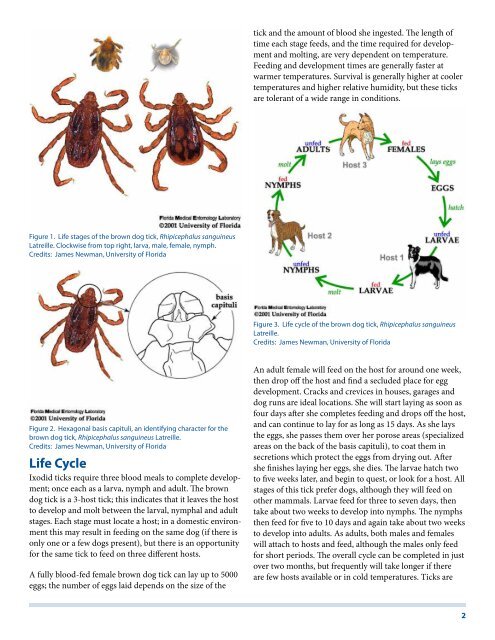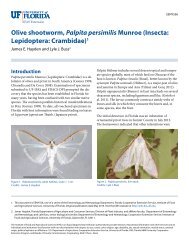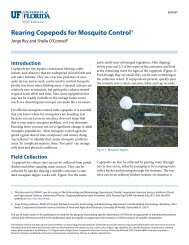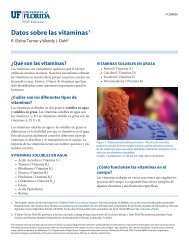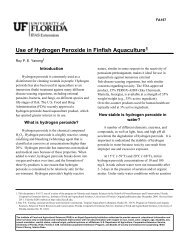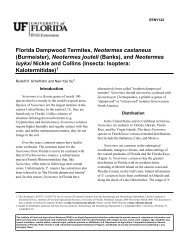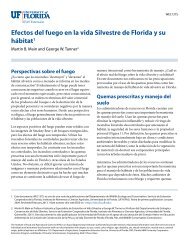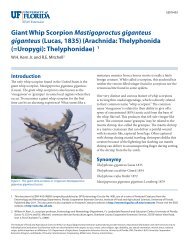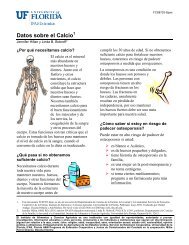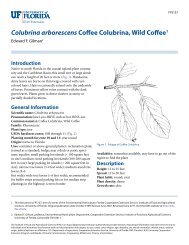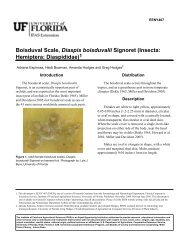Brown Dog Tick, Rhipicephalus sanguineus Latreille - EDIS ...
Brown Dog Tick, Rhipicephalus sanguineus Latreille - EDIS ...
Brown Dog Tick, Rhipicephalus sanguineus Latreille - EDIS ...
Create successful ePaper yourself
Turn your PDF publications into a flip-book with our unique Google optimized e-Paper software.
Figure 1. Life stages of the brown dog tick, <strong>Rhipicephalus</strong> <strong>sanguineus</strong><br />
<strong>Latreille</strong>. Clockwise from top right, larva, male, female, nymph.<br />
Credits: James Newman, University of Florida<br />
Figure 2. Hexagonal basis capituli, an identifying character for the<br />
brown dog tick, <strong>Rhipicephalus</strong> <strong>sanguineus</strong> <strong>Latreille</strong>.<br />
Credits: James Newman, University of Florida<br />
Life Cycle<br />
Ixodid ticks require three blood meals to complete development;<br />
once each as a larva, nymph and adult. The brown<br />
dog tick is a 3-host tick; this indicates that it leaves the host<br />
to develop and molt between the larval, nymphal and adult<br />
stages. Each stage must locate a host; in a domestic environment<br />
this may result in feeding on the same dog (if there is<br />
only one or a few dogs present), but there is an opportunity<br />
for the same tick to feed on three different hosts.<br />
A fully blood-fed female brown dog tick can lay up to 5000<br />
eggs; the number of eggs laid depends on the size of the<br />
tick and the amount of blood she ingested. The length of<br />
time each stage feeds, and the time required for development<br />
and molting, are very dependent on temperature.<br />
Feeding and development times are generally faster at<br />
warmer temperatures. Survival is generally higher at cooler<br />
temperatures and higher relative humidity, but these ticks<br />
are tolerant of a wide range in conditions.<br />
Figure 3. Life cycle of the brown dog tick, <strong>Rhipicephalus</strong> <strong>sanguineus</strong><br />
<strong>Latreille</strong>.<br />
Credits: James Newman, University of Florida<br />
An adult female will feed on the host for around one week,<br />
then drop off the host and find a secluded place for egg<br />
development. Cracks and crevices in houses, garages and<br />
dog runs are ideal locations. She will start laying as soon as<br />
four days after she completes feeding and drops off the host,<br />
and can continue to lay for as long as 15 days. As she lays<br />
the eggs, she passes them over her porose areas (specialized<br />
areas on the back of the basis capituli), to coat them in<br />
secretions which protect the eggs from drying out. After<br />
she finishes laying her eggs, she dies. The larvae hatch two<br />
to five weeks later, and begin to quest, or look for a host. All<br />
stages of this tick prefer dogs, although they will feed on<br />
other mammals. Larvae feed for three to seven days, then<br />
take about two weeks to develop into nymphs. The nymphs<br />
then feed for five to 10 days and again take about two weeks<br />
to develop into adults. As adults, both males and females<br />
will attach to hosts and feed, although the males only feed<br />
for short periods. The overall cycle can be completed in just<br />
over two months, but frequently will take longer if there<br />
are few hosts available or in cold temperatures. <strong>Tick</strong>s are<br />
2


